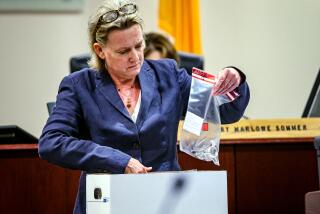
The spectacular collapse of New Mexico’s criminal prosecution of Alec Baldwin in the deadly “Rust” movie shooting laid bare nearly three years of errors by state officials who were eager to prove themselves on a world stage.
Legal experts had long said it was a risk to charge Baldwin with involuntary manslaughter, a felony, for the 2021 death of cinematographer Halyna Hutchins, whom the actor accidentally shot while preparing for a scene with a firearm. Baldwin had been told — incorrectly — that his prop gun contained no actual ammunition.
New Mexico First Judicial District Court Judge Mary Marlowe Sommer threw out Baldwin’s charge late Friday following a day-long hearing in which defense attorneys alleged Santa Fe County deputies and a special prosecutor concealed potential evidence — a bag of bullets an Arizona retired police officer turned in after the incident — that may have proved helpful to Baldwin’s case.

“If this conduct does not rise to the level of bad faith, it certainly comes so near to bad faith to show signs of scorching,” Marlowe Sommer said, directing her scorn at prosecutor Kari T. Morrissey.
Baldwin, who had been facing an 18-month prison sentence if convicted, sobbed as he heard the decision.
Legal experts were stunned at what they said was the prosecution’s botching of the case. “What a catastrophic end to this case for the special prosecutor,” said Santa Fe attorney John Day, who was not involved in the case. “It was a disaster — a complete train wreck.”
The decision ends a years-long ordeal for the star that began in October 2021, when he accidentally shot cinematographer Halyna Hutchins with a prop revolver during a rehearsal.
Three days into the trial, Baldwin’s high-powered legal team had successfully steered the case away from issues Morrissey wanted to explore, including evidence Baldwin may have pulled the trigger. They focused on an investigation that failed to answer a central question in the “Rust” shoooting: Where did the live rounds originate?
The Baldwin criminal case may have been doomed from the start.

Santa Fe County sheriff’s deputies arriving at western movie location Bonanza Creek Ranch near Santa Fe on Oct. 21, 2021, were rattled by the mayhem. Two victims lay bleeding on the floor of an old wooden church, Hutchins and director Joel Souza. Armorer Hannah Gutierrez Reed appeared to be having a panic attack. Baldwin declined a deputy’s invitation to sit in a patrol car, saying he was smoking a cigarette.
Law enforcement officers were gobsmacked: How could two people filming a movie be shot with a prop gun held by one of Hollywood’s most famous actors?
As journalists from around the world descended on Santa Fe, the sheriff and district attorney projected swagger. The sheriff was preparing for a reelection fight. At a news conference six days after the shooting, Dist. Atty. Mary Carmack-Altwies was asked whether Baldwin might be charged. “All options are on the table,” she told the crowd.
Pressure quickly mounted after Baldwin told ABC News anchor George Stephanopoulos that he didn’t pull the trigger. Gun enthusiasts howled, saying that gun model doesn’t fire on its own.

By year’s end, sheriff’s detectives had made mistakes that would haunt the case.
The movie’s prop master threw bullets from other actors’ weapons into the trash. The “Rust” prop truck, which held guns and ammunition, wasn’t searched for nearly a week. And it took another month before detectives showed up with a warrant at the Albuquerque prop house of weapons and ammunition provider, Seth Kenney.
The deputies found the military green ammo box they were looking for — Thell Reed, the armorer’s father, told investigators it contained live bullets that may have been the same batch as those on “Rust” — but it was empty.
Baldwin’s team asserted it was Kenney who co-mingled real bullets with dummies — an allegation that Kenney has denied, including while testifying Friday.
Cinematographer Halyna Hutchins was killed on the set of “Rust” in October 2021. A judge dismissed the involuntary manslaughter case against star Alec Baldwin in July 2024.
Adding another wrinkle, violent tests of Baldwin’s revolver at the FBI Laboratory in Virginia in mid-2022 fractured key gun components.
“I don’t think anyone would say this was a good, clean law enforcement investigation,” Day said. “And the prosecutors compounded the problems with their own missteps and poor judgment calls.”
After more than a year of investigating, the sheriff shipped the case to prosecutors so they could make charging decisions. The D.A. had hired a special prosecutor to help. It looked like a powerful team.
Carmack-Altwies was a progressive Democrat. The first special prosecutor, Andrea Reeb, was a Republican who championed gun rights.
But emails between the pair, later turned over to Baldwin’s team, revealed that Reeb had joked that prosecuting Baldwin could boost her state House campaign. To some, the disclosure made it look like Baldwin’s prosecution was politically motivated because many conservatives dislike Baldwin, who lampooned former President Trump on NBC’s “Saturday Night Live.”
Further, prosecutors blundered in January 2023 by adding a “gun enhancement” when filing involuntary manslaughter charges against Baldwin and Gutierrez Reed. The enhancement carried a mandatory five-year prison sentence but wasn’t on the books at the time of the “Rust” shooting, forcing prosecutors to scale back.
Reeb stepped down and Carmack-Altwies soon followed. That’s when Morrissey, a respected Albuquerque criminal defense lawyer, dug into the case.
Baldwin’s lead attorney, Luke Nikas, flew to New Mexico. He gave Morrissey evidence that he said showed Baldwin’s gun had been modified before arriving on set, according to court filings. With little time before a pivotal hearing, Morrissey dropped charges against Baldwin.

The “Rust” star immediately traveled to Montana to finish filming the movie. Meanwhile, Morrissey ordered more tests to determine whether Baldwin’s gun had a hair-trigger, as the defense team suggested.
Arizona gun expert Lucien Haag rebuilt the revolver, and ultimately concluded the gun hadn’t been modified. He was also convinced Baldwin pulled the trigger.
By last summer, tensions between Morrissey and Baldwin’s team were growing. But Morrissey offered Baldwin a deal in October to plead guilty to negligent use of a deadly weapon, a misdemeanor, and receive a suspended sentence. Weeks went by with no answer. Then Morrissey learned Baldwin’s team had shared the plea details with NBC News and planned to sue the state of New Mexico. Baldwin also allegedly pressured a crew member to be interviewed in a documentary Baldwin commissioned about himself, according to an April court filing by the prosecutor.
Morrissey withdrew the offer, sending the case to a grand jury. Baldwin was indicted in January and pleaded not guilty.
Beloved ’30 Rock’ and ‘SNL’ actor. Target of tabloids and conservatives. Alec Baldwin knows the limelight, but nothing quite like this.
The trial, which began Wednesday, was to be the most-publicized court action in New Mexico’s 112-year history. Legal experts saw it as a huge gamble by the prosecution.
“This case clearly should not have been criminally brought,” New York defense attorney Duncan Levin said Thursday. “The shooting was a tragic mistake but mistakes are not crimes.”
It wasn’t long before the case brought by Morrissey and fellow prosecutor Erlinda O. Johnson started to fall apart. Baldwin’s team filed a motion to dismiss the case after the second day of testimony. Marlowe Sommer called an 8:45 a.m. hearing Friday for the lawyers and told the jury to report by 9:30 a.m.
Spiro began Friday’s hearing by accusing Morrissey of signaling directions to her witnesses. Nikas then launched into a litany of alleged evidence violations, stemming from a bag of bullets that Troy Teske, a retired police officer who lives in Arizona, turned over to the Sheriff’s Office in March — potential evidence that was not disclosed to the defense.

Morrissey insisted the envelope contained nothing of “evidentiary value” because the bullets remained in Arizona — far from the “Rust” set.
“This defies everything they teach you in law school, and when starting out as a prosecutor,” University of New Mexico law professor Joshua Kastenberg said. “Prosecutors should never determine what evidence is relevant — that’s up to a judge.”
With a stern look, the judge donned blue latex gloves and opened the evidence envelope with scissors.
Marlowe Sommer directed crime scene technician Marissa Poppell to categorize the bullets.
Gasps rippled through the courtroom when it was revealed that three bullets had casings stamped with Starline Brass — the identifying marker of the deadly bullets on “Rust.”
Furious, the judge scrapped the day of testimony and sent home the jurors who had been waiting in a back room. Johnson, the new prosecutor, resigned from the case and took a seat on a bench reserved for the public.

The two sides clashed over the value of the Teske bullets. Teske was a former friend of Kenney, the ammo provider, and a current friend of Thell Reed. Baldwin’s lawyers argued the bullets might show a connection to Kenney, one of Morrissey’s main witnesses.
Morrissey disagreed, saying the bullets only pointed to Thell Reed. She has alleged his daughter brought some to the “Rust” set.
The judge also was deeply troubled that sheriff’s deputies logged the Teske bullets under a different case number, not the one for “Rust” evidence, making it impossible for defense attorneys to find on their own.
Marlowe Sommer grilled the lead detective, Alexandria Hancock. The judge asked whether Morrissey had participated in discussions this spring about the Teske bullets.
“Yes,” Hancock said. Louder gasps were heard in the courtroom.
At the end, Morrissey took to the witness stand to defend her conduct in the case. The judge was not swayed.
“There was no excuse for what happened from a prosecutorial standpoint,” Kastenberg said. “The recriminations are just starting.”

“Rust” legal wranglings are not over.
Certain civil lawsuits against Baldwin and the producers, including from Hutchins’ family members, remain unresolved.
“We respect the court’s decision,” said Brian Panish, lawyer for Hutchins’ husband, Matthew, after the judge dismissed Baldwin’s criminal case. “We look forward to presenting all the evidence to a jury and holding Mr. Baldwin accountable for his actions in the senseless death of Halyna Hutchins.”

Gloria Allred, who represents the victim’s Ukranian family, added: “The dismissal of the criminal case against Alec Baldwin is in no way, shape or form an exoneration of him.”
Others took a more charitable view, including LeAnn Brightwell, 80, who moved to Santa Fe two years ago from Palm Desert.
“I never thought he was guilty of murder; they shouldn’t have charged him,” Brightwell said. “What a horrific thing to know that you killed someone — that’s punishment enough.”
More to Read
Inside the business of entertainment
The Wide Shot brings you news, analysis and insights on everything from streaming wars to production — and what it all means for the future.
You may occasionally receive promotional content from the Los Angeles Times.














